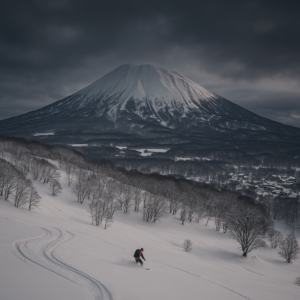Niseko’s Resort Boom at a Crossroads: Global Opportunity, Local Strain, and National Security
Once a quiet Hokkaido ski town known only to local enthusiasts, Niseko has transformed into one of Asia’s premier resort investment destinations. World-class powder snow, a thriving international community, and rising tourism demand have propelled its real estate market into global focus.
But as the resort continues to evolve, recent events—including the bankruptcy of a major China-backed development—raise important questions: How sustainable is Niseko’s growth? Can Japan maintain economic openness while protecting national security and social balance?

A Boom Fueled by Global Demand
Niseko’s rise began in the early 2000s, when Australians sought alternatives to North American ski resorts after 9/11. Its high-quality snow and laid-back lifestyle quickly drew foreign interest—not just from tourists, but from high-net-worth investors seeking second homes, rental income, or long-term appreciation. Over the past decade, land prices have more than doubled. In 2025, commercial land near Hirafu-zaka exceeded ¥500,000/sq.m.
Today, nearly 20% of Kutchan Town’s residents are non-Japanese nationals, and luxury developments dot the region. Niseko is no longer a secret—it is a symbol of Japan’s global appeal.
Cracks in the Snow: Chinese Developer Goes Bankrupt
In April 2025, Tokyo District Court began bankruptcy proceedings for La Plume Niseko Resort SPC, a special-purpose vehicle funded by a Chinese parent company. The project aimed to deliver 219 luxury rooms and five private villas, making it one of the area’s largest resorts. But construction stopped at just 30% completion due to unpaid contractor fees.
With liabilities estimated in the billions of yen, the halted site—now a half-built, tarp-covered structure—is an unwelcome symbol of risk in an otherwise booming town. Whether this is an isolated incident or a sign of broader overheating remains to be seen.

Labor Shortages: A Growing Bottleneck
While foreign visitor numbers are climbing—738,800 overnight stays in FY2023 alone—the tourism industry faces a severe labor shortage. Wages in winter peak season exceed ¥2,000 per hour, with English-speaking staff commanding up to ¥3,000. Service sector costs are rising so quickly that ¥3,000 hamburgers and ¥2,000 ramen are now common.
Japan’s tourism sector is currently the most labor-starved industry in the country. This labor constraint could become a ceiling on future growth, especially in remote areas like Niseko, where staff housing and workforce retention are chronic challenges.
The “Niseko Price” and Local Pushback
Rising prices, driven by foreign capital and wage inflation, are triggering resentment. On social media, “Niseko Price” is shorthand for the area’s perceived disconnect from reality. In response, Niseko Town has issued a “Curry Rice Index” to highlight that basic living costs remain lower than the national average, attempting to rebalance public perception.
But perception matters—and the gap between tourist experience and local life is widening.

National Security Concerns: Foreign Land Ownership in Focus
However, not all aspects of Niseko’s boom inspire confidence. A significant portion of investment comes from foreign entities, including those from nations like China and Russia, which some view as non-friendly to Japan’s interests. Personally, I believe Japan should consider restricting land purchases by such countries to safeguard national security.
Strategic locations like Niseko, with proximity to infrastructure, tourism assets, and even freshwater sources, could pose risks if controlled by entities with conflicting geopolitical agendas. This is not about rejecting global investment—but about ensuring Japan’s long-term security is not compromised by unchecked foreign ownership.
Other democratic nations such as Australia, New Zealand, and Canada have already adopted targeted restrictions. Japan may benefit from considering a similar policy toolkit.
The Path Forward: Sustainable and Secure Growth
Despite recent setbacks, Niseko still has a bright future—if the town and nation act wisely. Some key steps include:
-
Encouraging smaller, locally integrated developments over mega-resorts
-
Investing in workforce development and affordable housing
-
Introducing foreign land ownership transparency and review thresholds
-
Promoting ESG-aligned tourism and long-term cultural stewardship

Conclusion: Niseko’s Future – Prosperity with Prudence
Niseko stands at a crossroads. Its real estate market, buoyed by global demand and strong tourism trends, holds immense potential. But incidents like the La Plume bankruptcy remind us to proceed with caution. As foreign investment deepens, Japan must think not only about economic returns but also about sovereignty, sustainability, and social cohesion.
By addressing national security concerns and investing in long-term infrastructure and local communities, Niseko can continue to thrive—not as a speculative boomtown, but as a model for balanced, thoughtful resort development.
What do you think?
How should Japan balance the benefits of global investment with the need to protect its strategic and cultural assets? Share your thoughts—I welcome a dialogue on the future of this snowy paradise.

Call to Action
If you are considering real estate investment in Niseko or other prime areas of Japan, I would be happy to share insights based on current market data, regulatory developments, and exclusive off-market opportunities.
📩 Feel free to reach out via email yamamoto@yamamoto-property.jp or through my website:
Contact us. Let’s explore how we can build sustainable, secure, and value-driven real estate strategies together.
Source:
Toshihiko Yamamoto is the founder and principal broker of Yamamoto Property Advisory, a distinguished real estate brokerage in Tokyo that specializes in luxury residential and investment properties for an international clientele. His firm caters to discerning investors seeking premier properties for personal use and income-generating whole buildings for investment purposes.A licensed realestate broker in Japan, Mr. Yamamotoholds an MBA from Bond University in Australiaand a Certified Commercial Investment Member (CCIM) designation from the CCIM Institute in the United States. His extensive international experience, having lived abroad in Australia and the United Kingdom, equips him with a nuanced understanding of global real estate trends and the unique needs of foreign investors.With over two decades of experience in international business, Mr. Yamamoto has successfully conducted business with clients from more than 20 countries. As a seasoned property investor himself, he provides informed guidance to his clients as they navigate the intricacies of the Japanese real estate market to secure optimal investments.Discover more in his book, “The Savvy Foreign Investor’s Guide to Japanese Properties: How to Expertly Buy, Manage, and Sell Real Estate in Japan,” available on Amazon, iBooks, and Google Play.Connect with us through social media on Instagram, WhatsApp, and LINE for further information and expert assistance.



About the book
Amazon.com Link

#JapanRealEstate #NisekoInvestment #LuxuryResortProperty #InboundTourismJapan #JapanLaborCrisis #ForeignOwnership #NationalSecurityJapan #GeopoliticalRisk #SustainableGrowth #Niseko


